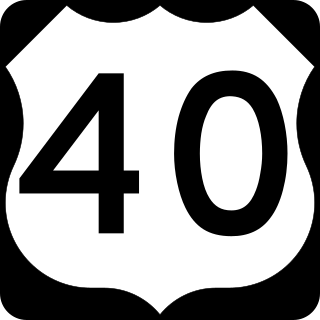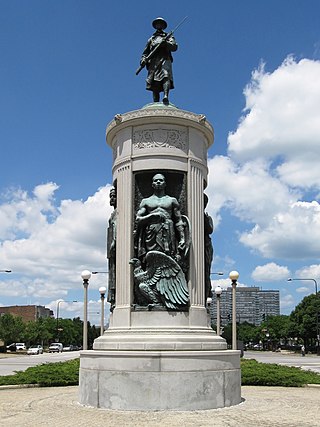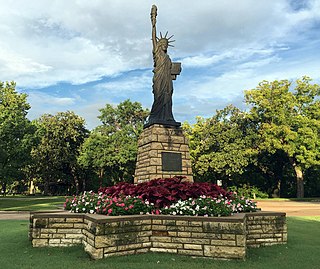Related Research Articles

U.S. Route 40 or U.S. Highway 40 (US 40), also known as the Main Street of America, is a major east–west United States Highway traveling across the United States from the Mountain States to the Mid-Atlantic States. As with most routes whose numbers end in a zero, US 40 once traversed the entire United States. It is one of the first U.S. Highways created in 1926 and its original termini were in San Francisco, California, and Atlantic City, New Jersey. US 40 currently ends at a junction with I-80 in Silver Summit, Utah, just outside Salt Lake City. West of this point US 40 was functionally replaced with I-80, and as these segments of I-80 were constructed the western portion of US 40 was truncated several times.

The California State Capitol Museum consists of a museum in and grounds around the California State Capitol in Sacramento, California, United States. The building has been the home of the California State Legislature since 1869. The State Capitol Museum has been a property in the California State Parks system since 1982.

Green Island in Ottawa, Ontario, Canada, is an island at the junction of the Rideau River, just off Sussex Drive in Ottawa at the Rideau Falls at the confluence with the Ottawa River. It is situated near the neighbourhood of New Edinburgh.

Charles Henry Niehaus was an American sculptor.

The Indiana State Soldiers and Sailors Monument is a 284 ft 6 in (86.72 m) tall neoclassical monument built on Monument Circle, a circular, brick-paved street that intersects Meridian and Market streets in the center of downtown Indianapolis, Indiana. In the years since its public dedication on May 15, 1902, the monument has become an iconic symbol of Indianapolis, the state capital of Indiana. It was added to the National Register of Historic Places on February 13, 1973 and was included in an expansion of the Indiana World War Memorial Plaza National Historic Landmark District in December 2016. It is located in the Washington Street-Monument Circle Historic District. It is also the largest outdoor memorial and the largest of its kind in Indiana.

Erected in 1927, the Victory Monument, is a bronze and granite sculptural monument, based on a concept by John A. Nyden, and sculpted by Leonard Crunelle. It was built to honor the Eighth Regiment of the Illinois National Guard, an African-American unit that served with distinction in France during World War I. It may be the only memorial statue dedicated to African-American soldiers of the Great War.

The Victory Highway was an auto trail across the United States between New York City and San Francisco, roughly equivalent to the present U.S. Route 40. It was created by the Victory Highway Association, which was organized in 1921 to locate and mark a transcontinental highway to be dedicated to American forces who died in World War I. A series of Victory Eagle sculptures were planned to mark the route, although only a few were actually built and placed.

Strengthen the Arm of Liberty is the theme of the Boy Scouts of America's fortieth anniversary celebration in 1950. The campaign was inaugurated in February with a dramatic ceremony held at the base of the Statue of Liberty. Approximately 200 BSA Statue of Liberty replicas were installed across the United States.
Confederate monuments and memorials in the United States include public displays and symbols of the Confederate States of America (CSA), Confederate leaders, or Confederate soldiers of the American Civil War. Many monuments and memorials have been or will be removed under great controversy. Part of the commemoration of the American Civil War, these symbols include monuments and statues, flags, holidays and other observances, and the names of schools, roads, parks, bridges, buildings, counties, cities, lakes, dams, military bases, and other public structures. In a December 2018 special report, Smithsonian Magazine stated, "over the past ten years, taxpayers have directed at least $40 million to Confederate monuments—statues, homes, parks, museums, libraries, and cemeteries—and to Confederate heritage organizations."

Over the Top to Victory, also known as Doughboy Statue and Their Country's Call Answered, is an outdoor bronze sculpture by John Paulding, formerly located at the Marion County Courthouse in Salem, Oregon, United States. The statue was commissioned by the American War Mothers and the Gold Star Mothers Club to commemorate the 87 men and one woman from Marion County who died in World War I.

There are more than 160 monuments and memorials to the Confederate States of America and associated figures that have been removed from public spaces in the United States, all but five of which have been since 2015. Some have been removed by state and local governments; others have been torn down by protestors.

Sedgwick County Memorial Hall and Soldiers and Sailors Monument (1911–13) is a Civil War monument on the grounds of the Old Sedgwick County Courthouse, in Wichita, Kansas. It was designed by E. M. Viquesney, with sculpture by Frederick Hibbard and the W. H. Mullins Manufacturing Company. The idea to construct a memorial to Sedgwick County Civil War veterans began with two local GAR posts in 1904, but sufficient funds were not available until in 1911. In that year the Kansas State Legislature passed a one-time county tax levy to fund the building of monuments in counties with a population of over 72,000.

The Carmel-by-the-Sea World War I Memorial Arch is a World War I memorial designed in 1919 by architect Charles Sumner Greene and located at Ocean Avenue and San Carlos Street center median divider in Carmel-by-the-Sea, California. The Memorial Arch was designated as a significant monument in the city's Downtown Historic District Property Survey, The Memorial Arch was recorded with the Department of Parks and Recreation on November 16, 2001. The Memorial Arch has been a historic landmark since November 1921, when it was built for Carmel World War I veterans. The Spanish Mission Revival style arch is constructed of Carmel sandstone.
References
- 1 2 3 "Dedication of war memorial by American Legion" (PDF). Bridgeport Chronicle-Union. Bridgeport, California. May 19, 1928. Retrieved April 16, 2020.
- 1 2 "Eagle Group Sign for Every County". Washington Citizen. Washington, Missouri. October 20, 1922. p. 1.
- 1 2 3 4 Whiteley, Lee; Whiteley, Jane. "Victory Eagles of Kansas". The Playground Trail. Retrieved August 16, 2015.
- 1 2 Moran, Margaret (July 15, 2013). "Rare World War I monument back on display in Truckee". Sierra Sun. Truckee, California. Archived from the original on September 14, 2016.
- ↑ "The Victory Eagle (sculpture)". Art Inventories Catalog. Smithsonian Institution. Retrieved August 16, 2015.
- ↑ "The Victory Eagle". Historic Mount Oread Friends. Retrieved April 16, 2020.
- ↑ Lysen, Dylan (May 29, 2019). "KU rededicates WWI memorial 'Victory Eagle' in new location on campus". Lawrence World-Journal. Lawrence, Kansas. Retrieved June 22, 2023.
- ↑ Yoho, Carol (2007). "Victory Highway World War I Veterans Memorial" . Retrieved August 16, 2015.
- ↑ Trout, Steven (Autumn 2006). "Forgotten Reminders: Kansas World War I Memorials" (PDF). Kansas History: A Journal of the Central Plains. 29: 200–215. Retrieved August 16, 2015.
- ↑ "Victory Eagle to Surmount Highway Shaft". Oakland Tribune. May 16, 1928. p. 5. Retrieved August 16, 2015– via Newspapers.com.

- ↑ Moran, Margaret (November 30, 2012). "A town 'victory': Truckee's World War I Eagle Monument to be restored". Sierra Sun. Truckee, California. Archived from the original on August 12, 2016.
- ↑ "Victory Highway Eagle Monument Rededication" (PDF). Echoes from the Past. Truckee Donner Historical Society: 2. March 2015. Retrieved April 16, 2020.
- ↑ Lockett, Jonathan (December 26, 2008). "Oakley aims to reclaim long lost statue". East County Times. Antioch, California. Retrieved April 16, 2020.
- ↑ Lockett, Jonathan (April 17, 2009). "Oakley fails in quest for World War I memorial". East County Times. Antioch, California. Retrieved April 16, 2020.
- ↑ Coetsee, Rowena (November 28, 2012). "Oakley collecting funds for veterans memorial". Contra Costa Times. Walnut Creek, California. Retrieved April 16, 2020.
- ↑ Cameron, Katrina (November 4, 2014). "Oakley to unveil 'Victory Eagle' at Veterans Day event". Contra Costa Times. Walnut Creek, California. Retrieved April 16, 2020.